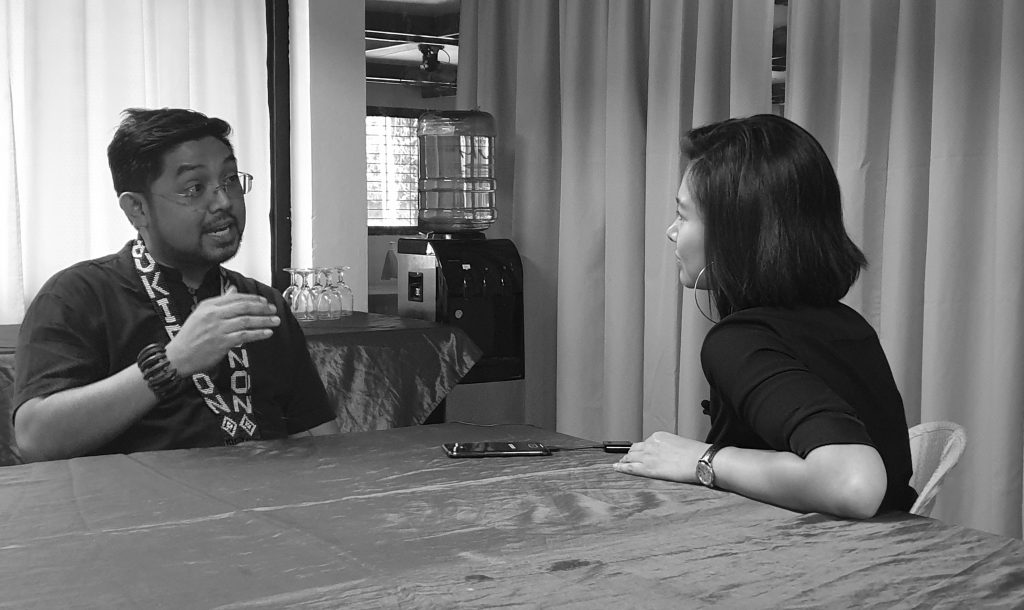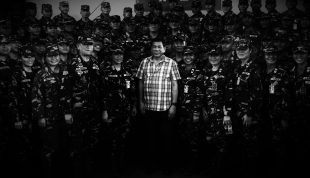In this third episode of our second series of the Philippines beyond Clichés, Associate Professor Nicole Curato of the University of Canberra’s Centre for Deliberative Democracy and Global Governance speaks with Professor Clarence Batan about the stereotype of the ‘tambay’, one commonly applied to the unemployed and youth transitioning from education. Nicole and Clarence drill down into the structural, social and class barriers that prevent ‘tambay’ from reaching their potential, and ask whether they are in fact, in a state of ‘waithood’.
Nicole Curato [NC]: [2:07] Hello! We are in the sidelines of the Philippine Sociological Society’s Annual Conference and we’re in Bukidnon and today we’re talking to the former president of the Philippine Sociological Society, Professor Dr Clarence Batan who will break the stereotype, ‘Tambays are lazy people.’ But first of all, welcome Yayet. We’re so excited with this topic because one of the biggest stereotypes, I think, in the Philippines is the idea that ‘tambays’ are lazy people. But first, let’s define what is a ‘tambay’?
Clarence Batan [CB]: [02:41] Well, ‘tambay’ is actually an English phrase on stand-by and based on my research, it’s an English phrase so it seems that it was during the American colonial period that we picked it up. However, historically, it’s rooted in the notion of indolence of Filipinos and there has been studies about Southeast Asians being lazy, right? Based on the colonisers’ configurations of their constructions of life at that time. So, I also subscribe to those articles written by Jose Rizal on the indolence of the Filipinos when he deconstructed that we are not really indolent. It was the colonisers who pegged us as indolent. Interestingly, this ‘tambay’ thing that I thought was a weird culture of Philippine society, I picked it up because of my field work at Talim Island about 20 years ago.
NC: [03:52] Where is Talim Island?
CB: [03:53] Talim Island is in the middle of Laguna Lake. Because I’ve been doing a lot of youth sociology thinking that we could do some development projects on them and the first thing was to do an ethnography of their life as fisherfolks because Talim Island is under such tension that there will be an airport at that time. The issue was to create a breach that will connect the mainland to the island. So that interest me and after doing fieldwork there for a number of years, I returned and I told them that I’m doing this youth thing and then they told me that after so many years of studying them, I should be writing something about ‘tambay’ and I said, ‘What do you mean?’ ‘Because they need jobs, they simply need jobs.’ And so, one of the interesting things was that I was thinking of studying about youth schoolwork transition, about those who are in school are actually given–translates their educational capital into work capital. So, it’s a school transition issue thing that I was looking at, only to find out that in my midst, is the issue of the ‘tambays’ and ‘tambays’ were thought to be useless because they do not have a job.
NC: [05:11] Right. So it’s a failed transition from school to work?
CB: [05:14] In fact, when I was doing my PhD work, it’s not a failed transition. These are those with no transition at all. Because while youth transition discourse were saying something about transition, when I was looking at my data, no transition is happening and that it only became very clear when we looked into the literature of those who are called NEETs (Not in Education, Employment, or Training) and so while all the statistics on young people when it comes to youth transition discourse point to the fact that we should be tracking where our young people are going, so if they are reaching full adulthood, we realised that there are those segments of young people not only in the Philippines who are not transitioning at all. That gave birth to the notion of NEET, used even by World Youth Report and statistics. And so, that’s the closest that I could think about when it comes to our ‘tambay’ phenomenon. But our ‘tambay’ phenomenon is different. In 1969 you could just imagine Erap Estrada having a film entitled ‘Istambay’ so you could just imagine–
NC: [06:27] Okay, what’s his character like?
CB: [06:30] He’s a stereotype character, he does not have a job, he is macho, drunk, and everything. And so in the late 1960s, imagine that term has been vilified into that same stereotype that we are facing at the moment. But that shifted I think historically in 2018 when Rodrigo Duterte made ‘tambay’ a national issue. It was very difficult for me to find more empirical proof to tell everyone that there is something more about ‘tambay’ than what you thought that there are stereotypes because all my fieldwork in the four research sites I went to, Talim Island, Manila, Bay Laguna, and in Calamba Laguna, points to the fact that it’s not all about them being lazy but simply because there is no job available. So, it is a structural issue than a personal issue really. And so, I was hoping that someone can pick it up in the policy realm and when Duterte was talking about contractualisation issue, which is one of the causes of ‘tambay’, the intermittent, insecure work arrangements, the precarity of employment and everything, that makes up the ‘tambay’ phenomenon. And so, that for me was a beautiful moment when he was talking about changing the contractualisation thing, right? But it changes in 13 June 2018 [14 June 2018] when in the midst of police officers he said, ‘You just pick up all these ‘tambays’ because they are criminals.’
NC: [08:27] So they’re even more stigmatised? Because already in popular culture, people who are on stand-by or ‘tambay’ are thought to be, yeah, they are not looking for jobs, they just go out drinking, they make trouble, they hang out in the street corner and hassle everybody. So, based on your research, what’s the deal? Is that stereotype correct?
CB: [08:46] No, it’s not. It’s because there are many types of ‘tambays’. What is so sad about that stereotype is that that is stereotypical of the poorest ‘tambays’. So, in my research, when it comes to vulnerability scale, there are the most vulnerable, meso vulnerable, and the least vulnerable. The most vulnerable are those stereotypical ‘tambay’ who we thought very, very poor, uneducated, and what have you. The second one are those who graduated high school in fact. Those who graduated high school but cannot transition really because there are no jobs available, even if they have the potential. They are the group who are really waiting because they don’t know what to do. The Filipino society is expected to make them finish whatever college or technical work there is but they cannot because there is no access to education and to work. They cannot be accepted in work too because they are just high school, under-qualified. The third type, which for me is the least vulnerable is actually the college-educated and to just give you a very, very disheartening scenario, imagine an island where women were given a chance to study college and usually they take education. And so, they finish education but there’s one legitimacy issue always when it comes to finishing education with is the LET, the Licensure Exam for Teachers, which costs money. And in Talim Island, there are so many women who finished education, who cannot transition into getting a job because they cannot pass the exam which is reflective of the entire country’s condition when it comes to licensure for teachers. So, even licensure examinations produce ‘tambays’ because they cannot transition into something.
NC: [11:04] So you have a skill set but there are no opportunities, state, society, structures cannot respond to the supply of talent, right? Basically this is talent.
CB: [11:14] Correct. And so, when you talk of the ‘tambay’ phenomenon, I don’t see it as just one poor, lazy, individual not wanting to work. Even the socially problematised behaviours of drinking and smoking and what have you, I find that very, very problematic too because what we don’t see is the fact that there are women ‘tambays’ too. One of the stereotypical thing about ‘tambays’ is that they’re all males, right? The Duterte ‘tambay’ are all males, that’s not true really. There are those who really suffer, the women who actually suffer in the process because they cannot get the job and they cannot transition into. And so what do they do? They feel like they are just, even the notion of housework is something that is problematic when it comes to ‘tambay’ because I found out that there are also women who thought that they are ‘tambays’ because they are not earning. Their sense of housework is not in the political economy of things, not really labour. This is the whole thing about this capitalist society that we have and so if you’re going look into its dynamics, it’s sad.
NC: [12:41] But this is also class-based, right? I cannot imagine a private school kid who is jobless but will not be called jobless because this kid will be called as someone who is looking for himself or taking a gap year. So, is the term ‘tambay’, it’s operating on the level of class?
CB: [13:01] Yes, that’s true but again, my recent discovery of the notion of gap year is interesting for me because as we look into the class impact of this phenomenon, I see that each class has a way of dealing with the same thing. For me, it’s the same ‘tambay’ phenomenon but they have a way, like the notion of the gap year for me is technically ‘pagtambay’ right? It’s a situation in waiting and so sociology of youth discourse, the first concept was inactivity which we don’t subscribe to because it’s not really true that ‘tambays’ are inactive. So, that’s something that we have to look into. I think I’m subscribing more on the notion of precarity and waithood. I think that’s something that’s very exciting to look into. There are many ways by which work become precarious but I would like to have this side variable which is the waithood characteristic. And each of the class, young people at that, because most of those who are in waiting are really young. I am more excited at looking into the dynamics of waithood which has been the emerging concept we use to explain the Not in Education, Employment, or Training group of people.
NC: [14:48] I love the concept of waithood because it’s pregnant with possibilities. There are so many things that can happen when you’re waiting for something and you can realise it to something productive. But of course, what I also learned from you, you were talking about this earlier, is that President Duterte changed our perspective of the ‘tambay’ and I think one of his pronouncements is that at a certain time, there’s a curfew, all the ‘tambays’ in the street will be rounded up, I think in slum communities they call it SONA, right? They go zone by zone, look for the ‘tambays’, arrest them, some of them are even teenagers, so as a sociologist of youth, what’s your reading here?
CB: [15:16] Well, it’s really a problem of perspective when it comes to the president because for one, the issue of zoning and curfew is an issue of space. The reason why they are there because there’s really no space.
NC: [15:33] They have no living rooms, no public parks.
CB: [15:36] And it’s so urban, right? Because the ‘tambays’ in the rural areas such as in Talim Island works in a different, their space is so vast, right? But they still call themselves ‘tambay’ because they are just hanging out and so I really think our president should really look into more empirical data before really saying things out of his personal observations. I think that’s where the problem is coming from, when you have a president who probably does not have the time to read or to listen to researchers, it’s really a big problem. It borders to stupidity because if I say, you know what it’s really an issue of space, it’s an issue of structure, meaning there is no–the reason why they’re there because you cannot provide them livelihood. Why is it that they are unproductive? It’s because it’s the dismal situation of poverty in those areas and you cannot just change that by criminalising those people in the streets. And so, I really find him, I mean I thank him for making ‘tambay’ a real national issue but probably it’s just a start of more critique about how we treat young Filipinos and how we make sure that they reach full adulthood.
NC: [17:09] But why do you think that kind of claim that ‘tambays’ are dangerous is appealing to people from let’s say middle classes, right? Because the president enjoys a lot of support from middle class and elite communities and part of the reason is I think urban poor communities, particularly those who are well-off but also actually among some urban poor communities, find the ‘tambays’ threatening. So, why do you think there’s that impression?
Street children are at greater risk under the new president.
Saving street kids in Duterte’s Philippines
CB: [17:33] Well, I see the impression as related to how media has actually played the notion of ‘tambay’ in the popular culture. You see, ‘tambay’ is not really that violent. We use ‘tambay’ as a safe space to hang out.
NC: [17:50] Right. Within universities, ‘tambayan’ is your safe space. Or if you’re from Ateneo, it’s called a bench. [laughter]
CB: [17:56] This same concept. But I think in radio, in t-shirts, in all other popular culture materials, it has already been part and parcel of our culture but not to that–it plays out in that manner, it’s appealing because there is, para ka kasing tinutukso, it’s like a tease. And there’s something about that that’s appealing but for me, to the extent to which there is already symbolic violence happening, meaning you represent something that is not really representing the real issue, that for me is problematic. So, I think for example when my students are looking forward to their gap year, that gap year becomes a sense of articulation of their leisure time and what have you. But when leisure becomes unproductive, that becomes a problem. So what I think I’m arguing is that there is that element of enjoyment, happiness of waiting. But when is waiting becomes dangerous? When is it becomes threatening? It is when you cannot move at all because you’re not getting into any direction. I think that’s when the youth transition discourse comes into play.
NC: [19:41] Yes. Is this peculiar to the Philippines?
CB: [19:43] No, this is not. What is so exciting was when I was in Canada doing my PhD, my professor Dr Victor Thiessen, advisor, he was so convinced looking at youth transition discourse in Canada that there’s no such thing as ‘tambay’ phenomenon in Canada. But after a series of youth transition discourse after surveys after four waves, he saw that there is this group of young people not moving at all and he told me, ‘These are your ‘tambays’, Clarence. This is true.’ And this has been happening all over the world. In Japan and in Europe, they call it Not in Education, Employment, or Training, in Brasil, Los Niños, Las Niñas, the lost generation. So they call it in different ways. Even in Africa, Dr Honwana called it the phenomenon of waithood. And another one called it killing time. The notion of killing time amongst South Africans. And so there has been a lot of literature pointing to this effect. But with my fellow sociologists, they love that I use the term ‘tambay’/’istambay’ because that gives it a Filipino flavour and they really wanted me to just write about it because it may give Global South scholars a view that that at least for now, a phenomenon which is so localised and yet globalised may be starting some kind of discourse on the precarity of work brought about by structural issues, economic issues, and what have you.
NC: [21:40] I’ve never heard this concept theorised in such profound ways! So, I think, Yayet, I’d love to talk more but we have to wrap up. So, in summary, let’s talk about the cliche. Are ‘tambays’ lazy people?
CB: [21:52] No. They are not.
 Facebook
Facebook  Twitter
Twitter  Soundcloud
Soundcloud  Youtube
Youtube  Rss
Rss 


